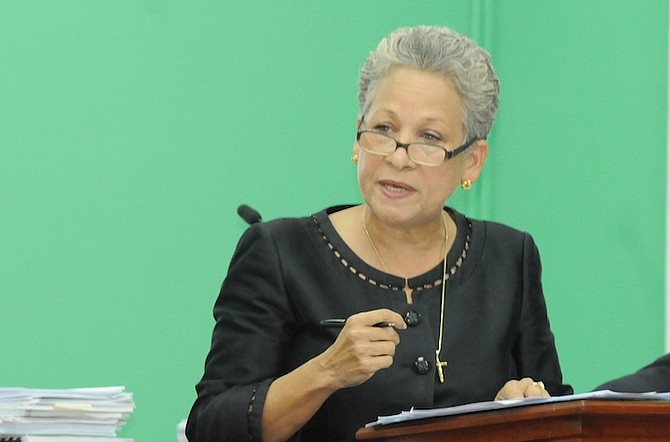By KHRISNA VIRGIL
Tribune Staff Reporter
kvirgil@tribunemedia.net
TRANSPORT and Aviation Minister Glenys Hanna Martin yesterday said the government is “actively considering” enhancing the capacity of the Department of Meteorology.
Speaking to The Tribune yesterday, Mrs Hanna Martin said the government also recently met with an international firm that specialises in weather equipment that recommended the country utilise a network of radars to ensure more effective forecasting.
This comes on the heels of accusations from forecasters in the department that the agency’s Doppler radar was not operating during parts of Hurricane Joaquin’s passage earlier this month. This claim has been strongly refuted by Mrs Hanna Martin and officials at the Meteorological office.
“There are plans to upgrade the Met Department,” Mrs Hanna Martin said. “The radar was purchased in 2005 and has limited range. This is something that should have been done a long time ago.
“As this is the case, we recently met with an international company and their recommendation is a network of radars.
“So we are going to be looking at the proposal with a view to enhancing the capacity of the department. This is under active consideration.”
She said the Ministry of Works is also collaborating with the Department of Meteorology in drawing up plans for a new location.
On Sunday, the department released the computer server logs that is evidence that the radar had been running continuously for 93 days, 20 hours and 51 minutes at the time of its download on October 21, according to Department of Meteorology Director Trevor Basden.
The disclosure directly contradicts last week’s controversial claims by forecaster Wayne Neely, who has insisted that the department’s Doppler radar was not functioning for several hours during the passage of Hurricane Joaquin.
The government repeatedly refuted the claims; however, Mr Neely maintained that as the category-four storm battered several Family Islands, the department was without the important weather instrument, adding that he would have never pinpointed issues with the radar if they did not exist.
In his statement, Mr Basden said: “The public is advised that the verification logs are used to substantiate the operability of the radar, as the log files are only produced when the radar has been radiating; while the radar is radiating it is able to produce echoes within its effective range of 150 miles when there is precipitation to record.
“These logs are produced daily at 8pm,” Mr Basden added. “Having regard to the ongoing speculation surrounding this issue, the department’s electronics manager and information technology technician determined it necessary to download these logs, a study of which affirmed the advice which was repeated by the minister, the director, and the senior deputy director of the Department of Meteorology that the radar was completely operational while Joaquin was in The Bahamas.”
The radar provides details on rainfall intensity, thunderstorms, and tornadic activity, including waterspouts effectively within a 150-mile range, Mrs Hanna Martin has said. Therefore, she said, the radar is best used by officials as a supplemental tool to satellite imagery, the lightning detection network and computer modelling from a variety of official international sources.
American expert Bob Dreisewerd told The Tribune last week that for the tool to be effective, the country needed at least two more radars.
Mr Dreisewerd, a meteorologist for 25 years and the chief development officer for Baron, a weather intelligence firm, said it was wise, though not necessary, for institutions to continually upgrade their radar technology.





Comments
Use the comment form below to begin a discussion about this content.
Sign in to comment
Or login with:
OpenID